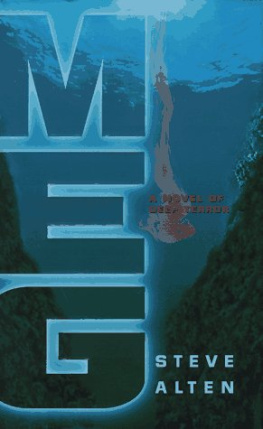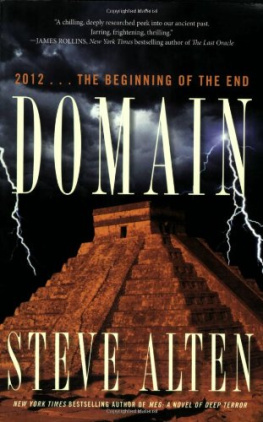Steve Alten - Meg: primal waters
Here you can read online Steve Alten - Meg: primal waters full text of the book (entire story) in english for free. Download pdf and epub, get meaning, cover and reviews about this ebook. year: 2004, publisher: Forge, genre: Detective and thriller. Description of the work, (preface) as well as reviews are available. Best literature library LitArk.com created for fans of good reading and offers a wide selection of genres:
Romance novel
Science fiction
Adventure
Detective
Science
History
Home and family
Prose
Art
Politics
Computer
Non-fiction
Religion
Business
Children
Humor
Choose a favorite category and find really read worthwhile books. Enjoy immersion in the world of imagination, feel the emotions of the characters or learn something new for yourself, make an fascinating discovery.
- Book:Meg: primal waters
- Author:
- Publisher:Forge
- Genre:
- Year:2004
- Rating:3 / 5
- Favourites:Add to favourites
- Your mark:
- 60
- 1
- 2
- 3
- 4
- 5
Meg: primal waters: summary, description and annotation
We offer to read an annotation, description, summary or preface (depends on what the author of the book "Meg: primal waters" wrote himself). If you haven't found the necessary information about the book — write in the comments, we will try to find it.
Meg: primal waters — read online for free the complete book (whole text) full work
Below is the text of the book, divided by pages. System saving the place of the last page read, allows you to conveniently read the book "Meg: primal waters" online for free, without having to search again every time where you left off. Put a bookmark, and you can go to the page where you finished reading at any time.
Font size:
Interval:
Bookmark:

Primal Waters
MEG 03
by
S t e v e A l t e n
"The immortality of my youth,
Lacked all direction, avoided truth,
Hustling through my middle age,
I burnt through years lost in a haze,
The bells now toll Father Time,
Fortunes fade, and so do mine..."
Jonas Taylor, excerpt from Memoirs
"What a drag it is getting old."
ROLLING STONES, 'Mother's Little Helper'
Prologue
Northwestern Pacific Ocean
18,000 Years Ago
Late Pleistocene
And an Ice Age once again dominated the Earth...
Officially it had begun some 1.6 million years earlier; ushering in a series of harsh glacial events, each of which lasted tens of thousands of years. Sandwiched between these cold spells were inter-glacial warming periods, the most recent coming to an abrupt end 74,000 years ago when the Toba caldera, a crater formed by a collapsed volcano on Samosir Island, Indonesia, erupted in one of the largest volcanic explosions the planet had ever experienced. This catastrophic detonation released 1,700 cubic miles of debris into the atmosphere, enveloping the globe in a dense blanket of volcanic smog which trapped the Earth's heat, triggering a runaway greenhouse effect. (In contrast, the Mount St. Helens eruption of 1980 yielded a mere 1.5 cubic miles.)
As global temperatures rose, great sections of polar ice from Greenland and the Arctic Ocean began melting. This deluge of freshwater inundated the Gulf Stream's North Atlantic Current, the conveyor belt of warm water that transfers heat to Europe and the Northern Hemisphere. The massive influx of freshwater diluted salt redistribution, preventing the process of down-welling, which, in turn, stifled the current's flow.
The combined effects of the Toba explosion and the cessation of the North Atlantic Current produced cataclysmic results. Temperatures plunged as much as one hundred degrees in a matter of hours, freezing animals in their tracks. Mountains of snow blanketed the Northern Hemisphere, wiping out food supplies. Large segments of human and animal populations starved, the few survivors forced to relocate.
Once more, the ice had reclaimed our planet.
Over the next 50,000 years, glaciers would continue to advance from the poles, with some of these continents of ice towering 13,000 feet. In North America, the Wisconsinian ice sheet would extend as far south as Pennsylvania, Indiana, Ohio, and Illinois, and as far east as Long Island. In Europe, the Eurasian ice sheet covered Scandinavia all the way to the Barents Sea.
With much of the water now locked up as ice, sea levels dropped over four hundred feet, drastically altering migration patterns. A land bridge formed in the Bering Strait, connecting the Eastern Hemisphere with the West, enticing prehistoric man and beast to cross over Asia into North America.
The Pleistocene Ice Age became a period of great transition. While some species evolved, most perished, unable to adapt. Among the primates, Neanderthal man yielded to Cro-Magnon, eventually giving way to the ascension of a new species homo sapiens modern man.
In the oceans, the expansion of the ice-caps around the poles created ideal breeding areas for plankton and krill, which, in turn, lured fish to the colder regions. It wasn't long before this sudden abundance of food began attracting whales. This shift in the food chain influenced the whales to make dramatic changes in their own migrational patterns, and the polar region became their new summer feeding grounds.
Autumn's chill and the return of the ice flows signaled the whales' retreat to the tropics, where an ancient enemy lurked in their breeding grounds, its own kind struggling to adapt to the cooling planet.
* * * * *
Rhinocodon typus moves just beneath the surface of the Pacific Ocean, its striking brownish-gray hide strewn with white dots and a grid of stripes. At thirty-two feet and 29,000 pounds, the juvenile male whale shark will grow another fifteen feet and add five tons to its girth by the time it reaches maturity. Despite its prodigious size, the creature is a docile giant and not a predator, its diet consisting of plankton, krill, squid, and sardines.
Gliding beneath the swarm of krill, the whale shark circles back suddenly, charging the surface with its flat, broad head. The wide slit of its lower jaw yawns open, creating a suction that forces large volumes of krill and seawater against the brushlike gill rakers located in the back of the shark's pharyngeal cavity. As these bristles strain food from the sea, hundreds of file-like teeth gnash the mouthful of planktonic organisms into pulp. The soup-like morsels are then flushed down the whale shark's tight gullet, the seawater diverted out its five-slitted gills.
Slapping its heavy tail along the surface, the speckled shark turns to feed again, unaware that, like the krill, it too is being stalked by a far larger adversary.
* * * * *
The monster glides east through depths cloaked in perpetual darkness, guided by its primordial senses. The shark, gargantuan predecessor of the modern-day Great White, is the most fearsome creature ever to inhabit the sea. At fifty-seven feet and 64,000 pounds, carcharodon Megalodon easily dwarfs its benign cousin, the whale shark.
Endowed with size, power, and senses that would put a nuclear submarine to shame, Megalodon has ruled the planet's oceans for tens of millions of years. It has survived the cataclysms that wiped out the dinosaurs and adapted to climate changes that devastated other prehistoric marine species. Intelligent as it is formidable, the brain of the elasmobranch is large and complex, controlling a plethora of organs that can see, feel, taste, and hear its underwater environment. A rogue hunter, the apex predator of all time is challenged only by members of its own kind.
But this latest Ice Age has done far more than simply cool the oceans, it has caused massive eustasis a process that freezes titanic volumes of water. As a result, sea levels have dropped, creating land bridges that have cut off tropical currents to vital Megalodon nursery sites. Sheer size, combined with a unique internal heat-exchange system powered by the Meg's swimming muscles, protects the adults against even the most frigid seas, but the smaller anatomies of the Megalodon young have succumbed to the cold.
Mortality rates among the newborns have reached critical levels. Evolution's most savage creation has begun to die out.
The monster that stalks the whale shark is a female, and she is pregnant, nearly to term. Nestled within her swollen oviduct are live young, each four to seven feet long, weighing upwards of twelve hundred pounds. Undernourished, with their bloated mother struggling to find food, the surviving pups have been forced to turn to cannibalism, the larger infants feeding upon their smaller, less fortunate siblings.
What was once a litter of thirteen has dwindled to eight.
A thin current of ocean sweeps inside the female's slack-jawed mouth, frozen in its demonic grin. Concealed behind this mask of complacency are scalpel-sharp triangular teeth, the edges all finely serrated, like a steak knife. The upper front rows are largest, six to seven inches in length, four inches wide along the root. Behind each nightmarish fang, folded back along the gum-line, are columns of replacement teeth, each row ready to rotate into place, supplanting a damaged or lost member. Twenty-four rows of teeth span the upper two quadrants of the jaw, twenty-two rows occupying the lower, in a bite so wide and devastating it could engulf, crush, and swallow a small elephant.
Next pageFont size:
Interval:
Bookmark:
Similar books «Meg: primal waters»
Look at similar books to Meg: primal waters. We have selected literature similar in name and meaning in the hope of providing readers with more options to find new, interesting, not yet read works.
Discussion, reviews of the book Meg: primal waters and just readers' own opinions. Leave your comments, write what you think about the work, its meaning or the main characters. Specify what exactly you liked and what you didn't like, and why you think so.












